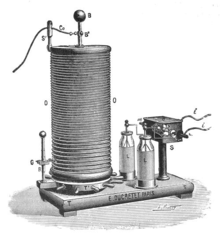Oudin coil
The Oudin coil , also known as the Oudin resonator , is a historical electrotechnical structure for generating high-frequency alternating voltage. The name goes back to the French urologist Paul Marie Oudin , who carried out his first work on this in 1899 together with the French physicist Jacques-Arsène d'Arsonval .
Structure and principle of operation
In principle, the Oudin coil is a Tesla transformer without an iron core, a type of resonance transformer . In contrast to the Tesla transformer, only one winding is used; the Oudin coil is a so-called autotransformer . The alternating voltage generated has frequencies of a few 10 kHz, depending on the system, the voltages generated are up to a few 10 kV when idling. The achievable performance is comparatively low, when it comes into contact with the high voltage, it collapses almost instantly to harmless values.
Almost at the same time, Nikola Tesla was experimenting on the Tesla transformers named after him.
application
The oudin coil was used around 1900 and the following years as a diathermy healing device, at a time when various types of electromedical experiments were popular and new. The form of treatment is not scientifically recognized, the oudin coil is still sometimes used for pseudo-medical purposes.
An Oudin resonator can be converted into an early form of radio receiver, the so-called detector receiver , which can receive strong medium-wave transmitters and make them audible in headphones.
swell
- ^ Mihran Krikor Kassabian: Roentgen rays and electro-therapeutics . Lippincott Company, 1907 ( online ).
Web links
- Pierre Dessapt: Raconte-moi la radio. Paul Marie OUDIN . 2007.
- Antonio Carlos M. de Queiroz: A Classical Tesla Coil with Top Load Tuning . April 5, 2006.

